
Your face is the first thing people notice about you. Anteface is a huge marker of attractiveness and a big part of your first impression. Anteface is the same thing as facial forward growth.
Anteface is the forward protrusion of the middle and lower third. Facial features that protrude forward are the nose and cheeks from the midface and the lips, chin, and jaw from the lower third. There is a correlation between anteface and attractiveness.
Professor Hermann Sailer, a University of Zurich professor for Maxillofacial Surgery and Pathology of the Masticatory System, was the first to coin the terms anteface and hyperanteface. Angelina Jolie and Naomi Campbell exemplify the anteface for females, and George Clooney and Pierce Brosnan for males.
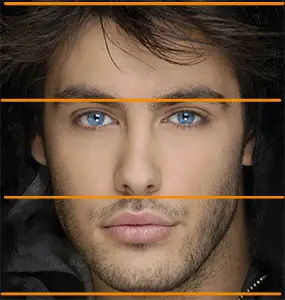
How to Tell If You Have Anteface
How do you know if you have anteface? It depends on your side profile. You have anteface or forward growth if the features of your middle and lower third protrude prominently forward.
The nasion is on top of the nose where the skull and face meet. Look at the picture below and notice how the middle and lower third’s facial features extend beyond an imaginary line from the nasion straight down to the bottom of the chin.
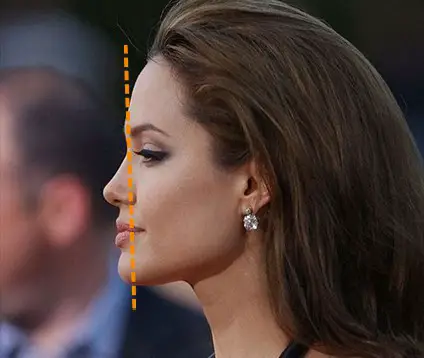
The angle of Facial Convexity
Plastic surgeons created a way to measure forward growth known as the facial convexity angle. Imagine a line from the glabella (brow ridge area) to the subnasale (spot right under the nose), and a line from the subnasale to the soft tissue pogonion (front of the chin). You then measure the angle between the two lines.
The angle usually ranges from 175 to 145 degrees. If you get a higher number, that means you have anteface or forward growth. A lower number means you have more of a mouthbreather profile and is considered less attractive. A face with a facial convexity angle of 165 degrees and above is forward, while less than 165 degrees is a recessed, or retro, face.
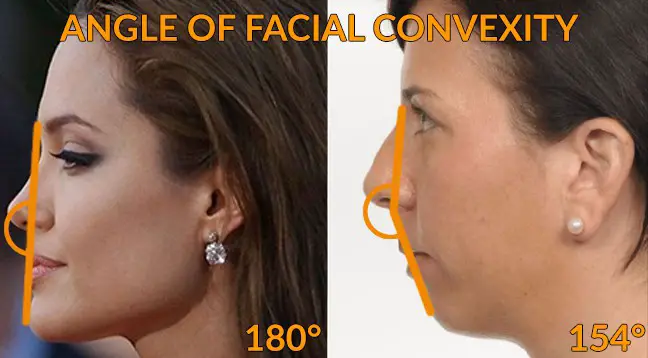
Is Anteface Attractive?
Anteface (forward growth) is conventionally attractive. A recessed (or retro) face is aesthetically unattractive, both from the front and profile views.
Well-defined and perfectly developed facial features are markers of beauty and attractiveness for both men and women. The ideal attractive face has a forward grown maxilla and mandible. The maxilla and mandible should be about 1 cm in front of the forehead, which will create a beautiful profile.
Hollywood actress Angelina Jolie is the poster girl for a forward face.
What Features Make an Attractive Face?
The development of an anteface and forward growth correlates with good development of pretty much every other facial feature. That’s because the maxilla is the core of the face, and this one bone controls the layout of every other facial bone.
Check out this Looks Theory episode for more info on the importance of the maxilla:
The maxilla and the mandible are the two major facial parts whose proper development is crucial in achieving facial attractiveness.
The Maxilla
The maxilla is your upper jawbone and a major bone of the face. It is part of the upper jawbone, the lower part of the eye sockets, and the lower parts of the sinus and nasal cavities. Many plastic surgeons consider the maxilla the most critical bone for facial aesthetics. The success of correcting poorly developed facial features has a lot to do with how the maxilla grew because it controls the layout of the other facial features like the eyes, nose, cheeks, chin, and jaw. A well-developed maxilla results in a more balanced face.
Proper craniofacial development during childhood, combined with proper oral posture, chewing on hard food, and having a healthy nutrition program, contribute to the development of a forward grown maxilla. There are also surgical procedures that will help achieve forward growth with a well-developed maxilla.
LeFort Osteotomy is a procedure that corrects deformities in the midface, such as misaligned teeth, and malformation of the jaw (maxillomandibular deformity) caused by an abnormally positioned jaw. Through this procedure, the surgeon creates maxillary fractures which he then uses to correct facial abnormalities.
Maxillomandibular Advancement Surgery is widely known to treat patients with obstructive sleep apnea (OSA).
The Mandible
The mandible makes up the lower third and is the strongest and biggest bone of the face. It forms the lower jaw and is the bedrock of the lower teeth. The mandible also defines the jawline. Like the maxilla, the jawbone also plays a vital role in facial aesthetics:
Ideally, a well-developed mandible consists of a long ramus and a straight, long mandibular body. The gonial angle, which is the angle formed when the ramus and mandible body intersects, determines if the mandible is well-developed and is a marker of bite force. The average gonial angle for a male is 124 +/- 6 deg, and for females, it is 122 +/- 4 deg.
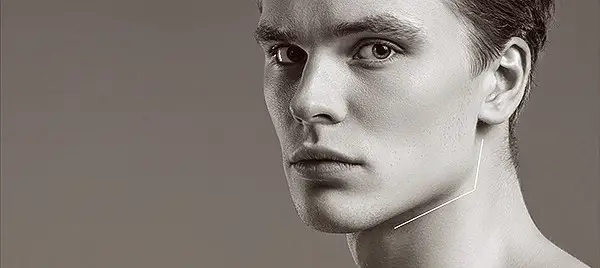
Chewing gum can create a well-defined jawline. The constant gum chewing will build up the masseter muscles, and over time alter the bone structure and shape. Losing weight is another way to show off a well-defined jawline.
Some ways to augment the jawline include:
- An alternative to plastic surgery to temporarily augment the jaw area is jaw filler injections for 3-4 months.
- Orthognathic surgery is a surgical procedure for correcting abnormalities of the jaw and face.
- Mandible osteotomy is available for those who have undersized mandible (micrognathia).
- Sagittal split osteotomy is a surgical procedure to treat those with an oversized mandible (prognathism).
Click here for more info about getting a good jawline.
The Ramus
The ramus is the short part of the mandible. And an attractive face usually has a sufficiently long ramus.
Ideally, the ramus should have a 5:7 ratio with the body of the mandible. If the ramus is too short, the face is considered unattractive. A long ramus caused by the overproduction of growth hormones (acromegaly) is an exception.
The ramus should be extended, visible, and prominent. People with high set ears will appear to have a longer ramus.
At a young age, chewing on hard food may help develop a long ramus. Having proper oral posture and sufficient nutrition will all contribute to the development of a long ramus and excellent forward growth.
Mewing Benefits on the Maxilla and Mandible
Developed by two British orthodontists, mewing leads to good facial development by the adoption of proper tongue posture, and it can work for adults to a limited degree. The method involves placing the tongue on the roof of the mouth. Over time, mewing can improve facial characteristics such as the jawline, nose, cheek, chin, and eyes.
Facial aesthetics require that both the maxilla and mandible are well developed. Mewing can reverse the recession of the maxilla and entire craniofacial complex. The following animation shows the basic facial progression of mewing:
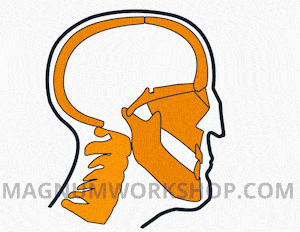
However, this is a very long term strategy and can take years.
Mouth breathing due to medical issues can cause the maxilla to elongate, resulting in a long and unattractive face. By mewing for many years, the maxilla rotates up and forward, making a face look better.
Achieving the ideal gonial angle is also possible with mewing, as the neck and jaw muscles push up on the mandible. With mewing, the jawbone is more parallel with the floor and not downswung. The gonial region of the mandible will also become more prominent.
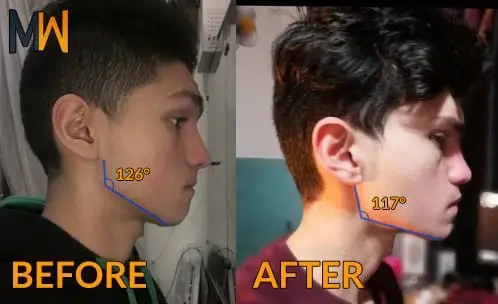
Similarly, mewing and proper tongue posture during childhood and development will produce the best effects in achieving forward growth.
For more info on mewing, visit our Ultimate Guide.

